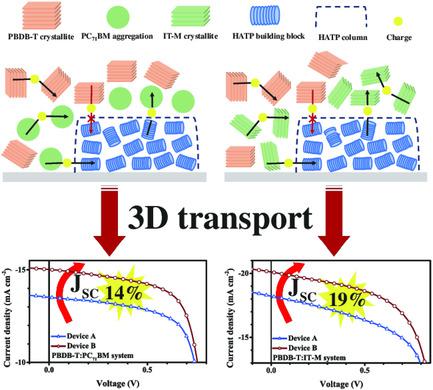Our official English website, www.x-mol.net, welcomes your feedback! (Note: you will need to create a separate account there.)
3D Charge Transport Pathway in Organic Solar Cells via Incorporation of Discotic Liquid Crystal Columns
Solar RRL ( IF 7.9 ) Pub Date : 2020-03-03 , DOI: 10.1002/solr.202000047 Tong Wang 1 , Meng-Si Niu 1 , Jia-Jia Guo 2 , Kang-Ning Zhang 1 , Zhen-Chuan Wen 1 , Jian-Qiang Liu 1 , Chao-Chao Qin 2 , Xiao-Tao Hao 1, 3
Solar RRL ( IF 7.9 ) Pub Date : 2020-03-03 , DOI: 10.1002/solr.202000047 Tong Wang 1 , Meng-Si Niu 1 , Jia-Jia Guo 2 , Kang-Ning Zhang 1 , Zhen-Chuan Wen 1 , Jian-Qiang Liu 1 , Chao-Chao Qin 2 , Xiao-Tao Hao 1, 3
Affiliation

|
In this work, a discotic liquid crystal (DLC) 2,3,6,7,10,11‐hexaacetoxytriphenylene (HATP) is used as the interlayer between poly(3,4‐ethylene‐dioxythiophene):poly(styrene sulfonate) (PEDOT:PSS) and the active layer to achieve 3D charge transportation for organic solar cells (OSCs). HATP exhibits a columnar structure with a dominantly edge‐on orientation. For a (non‐)fullerene OSC system based on face‐on orientation, HATP columns are favorable for the expansion of edge‐on and face‐on crystallite in the active layer. According to the surface energy, surrounding the HATP columns are mainly acceptors. The significantly improved electron mobility indicates that it is easier for the electron to hop into HATP columns to transport, which represents the formation of the 3D pathway. This transport mode typically can enhance the intermolecular charge transport and effectively suppress the generation of triplet excitons and recombination. Thus, the short‐circuit current density (JSC) is increased by 14% and 19% for fullerene and non‐fullerene systems, respectively. The power conversion efficiency is improved for non‐fullerene OSCs with different active layer thicknesses (≥150 nm) and fullerene OSCs with an active layer thickness of 140 nm. Overall, this work demonstrates an approach to introduce HATP columns on a PEDOT:PSS layer that has great potential to form a 3D pathway for achieving high‐performance (non‐)fullerene OSCs.
中文翻译:

通过结合盘状液晶列在有机太阳能电池中的3D电荷传输途径
在这项工作中,盘状液晶(DLC)2,3,6,7,10,11-六乙酰氧基三亚苯基(HATP)被用作聚(3,4-乙烯-二氧噻吩):聚(苯乙烯磺酸盐)之间的中间层( PEDOT:PSS)和有源层,以实现有机太阳能电池(OSC)的3D电荷传输。HATP呈柱状结构,主要为边缘取向。对于基于面向面取向的(非)富勒烯OSC系统,HATP色谱柱有利于扩展活性层中的面向边缘和面向面的微晶。根据表面能,HATP柱周围主要是受体。电子迁移率显着提高,表明电子更容易跳入HATP色谱柱进行传输,这代表了3D途径的形成。这种传输模式通常可以增强分子间电荷传输并有效地抑制三重态激子的产生和重组。因此,短路电流密度(对于富勒烯和非富勒烯体系,J SC)分别增加了14%和19%。对于具有不同活性层厚度(≥150 nm)的非富勒烯OSC和具有140 nm活性层厚度的富勒烯OSC,功率转换效率得到了提高。总的来说,这项工作演示了一种在PEDOT:PSS层上引入HATP色谱柱的方法,该方法具有形成3D途径以实现高性能(非富勒烯OSC)的巨大潜力。
更新日期:2020-03-03
中文翻译:

通过结合盘状液晶列在有机太阳能电池中的3D电荷传输途径
在这项工作中,盘状液晶(DLC)2,3,6,7,10,11-六乙酰氧基三亚苯基(HATP)被用作聚(3,4-乙烯-二氧噻吩):聚(苯乙烯磺酸盐)之间的中间层( PEDOT:PSS)和有源层,以实现有机太阳能电池(OSC)的3D电荷传输。HATP呈柱状结构,主要为边缘取向。对于基于面向面取向的(非)富勒烯OSC系统,HATP色谱柱有利于扩展活性层中的面向边缘和面向面的微晶。根据表面能,HATP柱周围主要是受体。电子迁移率显着提高,表明电子更容易跳入HATP色谱柱进行传输,这代表了3D途径的形成。这种传输模式通常可以增强分子间电荷传输并有效地抑制三重态激子的产生和重组。因此,短路电流密度(对于富勒烯和非富勒烯体系,J SC)分别增加了14%和19%。对于具有不同活性层厚度(≥150 nm)的非富勒烯OSC和具有140 nm活性层厚度的富勒烯OSC,功率转换效率得到了提高。总的来说,这项工作演示了一种在PEDOT:PSS层上引入HATP色谱柱的方法,该方法具有形成3D途径以实现高性能(非富勒烯OSC)的巨大潜力。



























 京公网安备 11010802027423号
京公网安备 11010802027423号